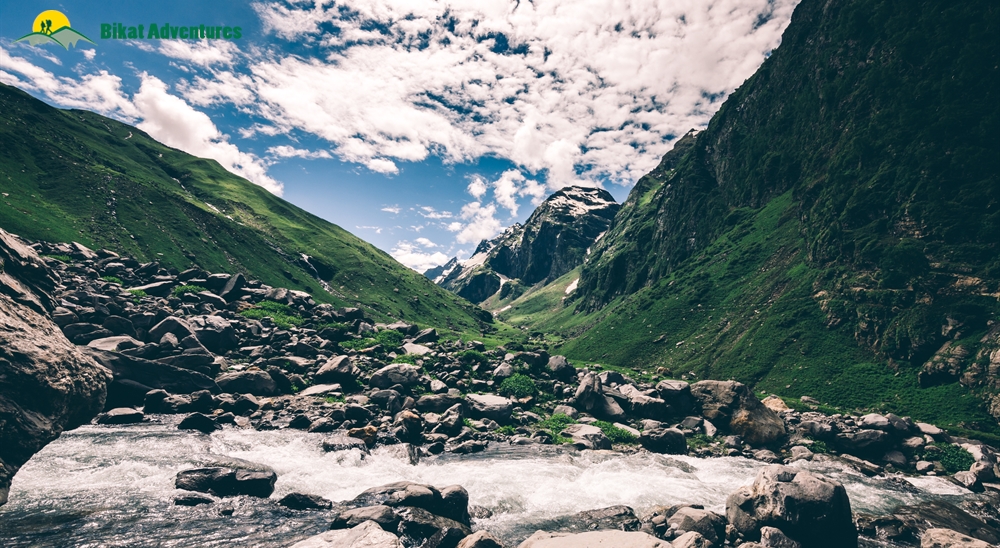The Hampta Pass Trek is a mesmerising adventure nestled in the Himachal Pradesh region of India. This trek offers a unique blend of contrasting landscapes, thrilling challenges, and unparalleled beauty, making it a must-visit for trekking enthusiasts. Spanning over five days, the Hampta Pass Trek takes you through lush green valleys, dense forests, pristine rivers, and high-altitude deserts, providing an unforgettable experience for all who dare to embark on this journey.
The Alluring Landscape of Hampta Pass
The Hampta Pass, perched at an elevation of approximately 14,100 feet, connects the lush Kullu Valley to the arid Spiti Valley. This stark contrast in landscapes is one of the primary highlights of the trek. The journey begins in Manali, a popular hill station in Himachal Pradesh, and traverses through various terrains, each more breathtaking than the last.
Lush Green Valleys and Forests
The trek starts from Jobra, a picturesque village near Manali, and ascends through dense pine forests and expansive meadows. The lush greenery of the Kullu Valley is a sight to behold, with vibrant wildflowers dotting the landscape. The soothing sound of the Rani Nallah river accompanies trekkers, adding to the serene ambiance.
Snow-Capped Peaks and Glacial Rivers
As the trial progresses, the scenery changes dramatically. Trekkers encounter snow-capped peaks, glacial rivers, and vast open spaces. The Chandratal Lake, often referred to as the “Moon Lake,” is a highlight of this segment. Its crystal-clear waters reflect the surrounding peaks, creating a magical, almost surreal atmosphere.
High-Altitude Deserts of Spiti Valley
Crossing the Hampta Pass itself is a challenging yet rewarding experience. Upon crossing, trekkers are greeted by the stark, arid beauty of the Spiti Valley. The landscape here is characterised by barren mountains, rugged terrain, and a unique tranquillity that is hard to find elsewhere.
Flora and Fauna: A Natural Wonderland
The Hampta Pass Trek is not only about the stunning landscapes but also about the rich biodiversity that thrives in these regions. The trek provides an opportunity to witness a variety of flora and fauna.
Diverse Plant Life
The trek’s lower regions are adorned with dense forests of pine, oak, and maple. As you ascend, the vegetation changes to alpine shrubs and wildflowers. The vibrant blooms of rhododendrons, Himalayan blue poppies, and primulas add splashes of colour to the greenery.
Wildlife Encounters
The region is home to a diverse range of wildlife. Trekkers may spot Himalayan birds like the Monal and the Snow Partridge. Occasionally, sightings of larger mammals such as the Himalayan brown bear and the elusive snow leopard are reported. The rich biodiversity of the region adds an element of excitement and unpredictability to the trek.
Cultural Insights and Local Experiences
The Hampta Pass Trek is also a cultural journey. The trail passes through several remote villages, offering trekkers a glimpse into the local way of life.
Traditional Himachali Villages
Villages like Chhatru and Balu Ka Gera are excellent spots to interact with the local Himachali people. Their hospitality is heartwarming, and trekkers can learn about the traditional practices, cuisine, and lifestyle of the residents. The locals’ simple yet fulfilling way of life offers a refreshing contrast to the hustle and bustle of city living.
Ancient Monasteries
In the Spiti Valley, ancient monasteries like Key Monastery provide spiritual respite and a peek into the rich Buddhist heritage of the region. These monasteries are architectural marvels, standing resiliently in the harsh climatic conditions, and are centres of peace and learning.
Preparing for the Hampta Pass Trek
While the Hampta Pass Trek is a rewarding experience, it requires adequate preparation. Here are some essential tips for trekkers:
Physical Fitness and Training
The trek involves significant altitude gain and varying terrains, so physical fitness is crucial. Regular cardio exercises, strength training, and endurance workouts are recommended at least two months prior to the trek. Acclimatisation days are also included in the itinerary to help trekkers adapt to the high altitudes.
Packing Essentials
Packing the right gear is essential for a comfortable trekking experience. Here’s a checklist of must-have items:
- Trekking boots: Sturdy, waterproof, and with good grip.
- Clothing: Layered clothing to adapt to varying temperatures, including thermal wear, fleece jackets, and waterproof outerwear.
- Backpack: A comfortable, 40-50 litre backpack with rain cover.
- Sleeping bag: Suitable for sub-zero temperatures.
- Trekking poles: To provide stability on uneven terrain.
- First aid kit: Including medications for altitude sickness, pain relievers, and basic first aid supplies.
- Other essentials: Sunglasses, sunscreen, a hat, water bottles, and snacks.
Permits and Regulations
Trekkers need to obtain permits from the Forest Department in Manali. It’s advisable to check the latest regulations and guidelines before starting the trek, as these can change based on environmental and administrative policies.
Best Time to Trek Hampta Pass
The optimal time to undertake the Hampta Pass Trek is from June to September. During this period, the weather is relatively stable, and the snow has melted, making the trails more accessible. Each season offers a unique charm:
- June to July: Lush greenery and blooming flowers.
- August to September: Clear skies and post-monsoon freshness.
Conclusion
The Hampta Pass Trek is a journey through some of the most spectacular landscapes in Himachal Pradesh. From lush valleys and dense forests to arid deserts and ancient monasteries, the trek offers a diverse and enriching experience. Whether you are an experienced trekker or a nature enthusiast looking to explore the Himalayas, Hampta Pass provides an adventure that is both challenging and immensely rewarding. Prepare well, respect the local culture, and immerse yourself in the breathtaking beauty of the Hampta Pass Trek.










